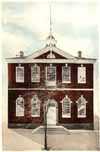Related Topics
..The Constitution
Our Constitution was not a proclamation written by a convention. It was a negotiated contract for uniting thirteen sovereign independent states. Nothing like that had ever been done voluntarily, and few nations have matched it in two hundred years, even with the use of force.
Twenty Five Years at the Center

|
|
Congress met in "Congress Hall" from 1790-1799 First 10 amendments, the "Bill of Rights," were added here. |
Philadelphia was the center of the nation from the time of the First Continental Congress (1775) until the nation's capital was moved to the District of Columbia in 1800. For thirteen of those years (from 1775 until the 1788 inauguration of George Washington as the first President under the Constitution) our governing concept was that of a confederation of sovereign states. The framework of our rules was a little vague at the beginning of that period, eventually becoming explicit when the Articles of Confederation were finally ratified in 1781. Until that rather late moment in the eight-year war, the thirteen rebel colonies governed themselves in a manner similar to thirteen nomadic tribes. Later on, when the Constitution was agreed to in 1787, there was another period of ambiguity until the newer rules actually began to apply. Speaking loosely, for thirteen years the country operated according to the Articles of Confederation. For another twelve years, the United States were absorbed in the task of transition from the Articles to the Constitution of a unified nation.
More discrete episodes in the development of the American Constitution start with the long formative period of English law stretching back to the Magna Charta, with a general trend toward greater authority for individual barons and nobles, and later even to the common English peasant. The Magna Carta began the slow evolution toward the Rule of Law, simply stated as making the king obey his own laws. By the reign of Queen Elizabeth I, the legal profession had evolved considerable sophistication, tending in the direction of the Judges handling the law and the King leading the armed forces, and the Catholic Church supplying many of the rules of everyday conflict. King Henry VIII reduced church control of the courts considerably, but the Anglican church still retained the property and legal authority for decades, slowly giving ground to a King who appointed the Archbishop of Canterbury, who controlled the rest of the church. By the time of the first Queen Elizabeth, the legal profession was headed by the Lord Chancellor, who at that time was Sir Francis Bacon. Somehow, word of Galileo's scientific method traveled to London, and Bacon is credited with converting English Law to English Common Law, essentially grafting the scientific method onto the court system. The system was one of observing what happened and developing a theory about why it turned out that way. Experiments were then applied to test the theory, resulting in the modification of the theory. Decisions were standardized for common forms of dispute, and punishments were varied, with varied outcomes. When the courts were satisfied with a uniform result, the situation was then reduced to codified standard laws, and experimental testing was lessened. Common Law gradually emerged and slowly gathered public respect as a sensible guide to running the country. At that point, judges and kings discovered they had less latitude for capricious or ill-founded decisions; the Rule of Law grew stronger.
By the time of the American Revolution, a number of colonies had developed their own charters and rules, and many customs like the right to a jury trial became accepted rules of society. Many such similarities between colonial rules and the final Constitution have been noticed, and it is traditional to give credit to some of them as having "originated" the later Constitutional provisions. Some of this is strictly factual, some of it may only be conjectural; it probably doesn't seriously matter
Originally published: Wednesday, June 03, 2009; most-recently modified: Friday, June 07, 2019